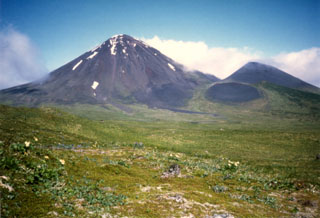Report on Semisopochnoi (United States) — 28 December-3 January 2023
Smithsonian Institution / US Geological Survey
Weekly Volcanic Activity Report, 28 December-3 January 2023
Managing Editor: Sally Sennert.
Please cite this report as:
Global Volcanism Program, 2022. Report on Semisopochnoi (United States) (Sennert, S, ed.). Weekly Volcanic Activity Report, 28 December-3 January 2023. Smithsonian Institution and US Geological Survey.
Semisopochnoi
United States
51.93°N, 179.58°E; summit elev. 1221 m
All times are local (unless otherwise noted)
AVO reported that fresh ash deposits on the flanks of Semisopochnoi’s Mount Cerberus were visible in webcam images during 27-28 December, indicating that activity at the N crater had resumed on 27 December. The deposits extended about 1 km from the vent. Ash plumes were not visible in satellite and webcam images, though a persistent steam plume rising as high as 1.5 km (5,000 ft) a.s.l. may have been carrying minor amounts of ash. Increased seismicity, including seismic tremor, had been recorded during the previous week. AVO raised the Aviation Color Code to Orange (the second highest level on a four-color scale) and the Volcano Alert Level to Watch (the second highest level on a four-level scale).
Seismic tremor and explosions were recorded during 30-31 December. Satellite and webcam images were obscured by clouds; no plumes were observed above the meteorological cloud deck around 4.7 km (15,000 ft) a.s.l., so any ash emissions would have been at low altitudes. Possible explosions were detected during 31 December 2022-1 January 2023. A small ash deposit extending around 2 km SSW of the N crater were visible in satellite and webcam images. A likely explosion occurred during 1-2 January based on elevated seismicity recorded on local seismometers and an infrasound signal recorded minutes later by an array at Adak. Minor steam-and-gas emissions were visible in partly cloudy satellite images. Low-level explosive activity persisted during 2-3 January, with minor steam emissions and a new ash deposit visible in webcam images.
Geological Summary. Semisopochnoi, the largest subaerial volcano of the western Aleutians, is 20 km wide at sea level and contains an 8-km-wide caldera. It formed as a result of collapse of a low-angle, dominantly basaltic volcano following the eruption of a large volume of dacitic pumice. The high point of the island is Anvil Peak, a double-peaked late-Pleistocene cone that forms much of the island's northern part. The three-peaked Mount Cerberus (renamed Mount Young in 2023) was constructed within the caldera during the Holocene. Each of the peaks contains a summit crater; lava flows on the N flank appear younger than those on the south side. Other post-caldera volcanoes include the symmetrical Sugarloaf Peak SSE of the caldera and Lakeshore Cone, a small cinder cone at the edge of Fenner Lake in the NE part of the caldera. Most documented eruptions have originated from Young, although Coats (1950) considered that both Sugarloaf and Lakeshore Cone could have been recently active.
Source: US Geological Survey Alaska Volcano Observatory (AVO)

